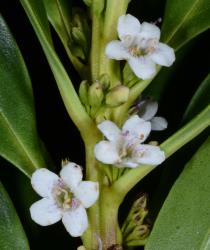- Taxon
- Weed
- Gallery
Large shrub or small tree with numerous branches from base, generally with dense bushy habit. Bark smooth. Lf buds green and ± viscid when fresh, often drying black. Petiole c. 1 cm long, scarcely distinct from attenuate base of lamina. Lamina 4–12 × 1.25–3 cm, elliptic or narrowly elliptic, thick and semi-succulent, finely dotted with pellucid glands, mostly serrulate in the upper 1/2, occasionally entire or, especially in juvenile lvs, more extensively serrulate or serrate; apex mostly acute. Fls 1-few; pedicels c. 5 mm long at anthesis. Calyx c. 3 mm long, lobed nearly to base; lobes lanceolate-acuminate. Corolla 7–8 mm diam.; lobes > tube, rounded, white with fine purple dots, white-bearded inside towards base. Style hairy. Drupe c. 6 mm diam., broad-oblong or broad-ovoid (almost as wide as long), shining deep purple.
[From: Webb et al. (1988) Flora of New Zealand. Volume 4.]
Flowering: Sep.–Jun.




